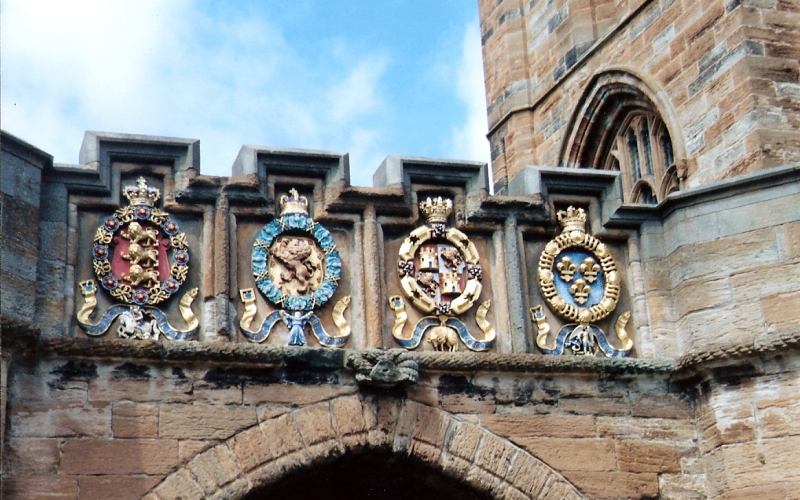
Motto: Virescit vulnere virtus (Courage grows strong at a wound)
Historic Seat: Linlithgow Palace, Stirling Castle, Edinburgh Castle
District: Renfrewshire
Associated Surnames: Cook, Crookshanks, Cruickshanks, Duilach, France, Francis, Garrow, Jameson, Jamieson, Lombard, Lorne, Maccmie, MacCloy, MacGlashan, MacKirdy, MacMichael, MacMunn, MacMutrie, Moodie, Munn, Sharp
Associated Tartans:
Early Stewart Genealogy and History:
(Excerpt from "The Scottish Clans and Their Tartans", James Grant, 1906)
There are four ways of spelling this surname - Stewart, Steuart, Stuart, and Steward - besides the Gaelic verion of it - Stiubhard. The ancient form and original name, as spelt by the Royal Family, is Stewart, taken from the office of Lord High Stewart of Scotland, which they held for nearly two centuries before they came to the throne.
The first traceable progenitor of this gallant and royal race was a Norman, Alan, Lord of Oswestry, in Shropshire, whose famly, almost immediately after their settlement in Scotland, became completely identified with the nationality of their new country, and were associated with all its brightest achievements and deepest calamities.
Walter, the son of Alan, obtained from David I, in the twelfth century, a charter of the burgh and lands of Renfrew; and Malcolm IV, by charter, made the office of High Steward hereditary in the family.
In 1263, Alexander, the Lord High Steward, together with the King, led the Scottish army at the battle of Largs, when the Norwegians, under King Hacho, were totally defeated. King Alexander III was wounded in the face by an arrow, and the Great Steward, fighting in the van, was slain. In 1286, his son, James the Steward, was appointed one of the Regency on the death of the young Queen Margaret; during the Treaty of Paris in 1303, he was one of the commissioners sent to watch over Scottish interests.
Walter, the High Steward, when in the flower of his youth, with Douglas, led the left wing of the Scottish army at Bannockburn,1 and was knighted on the field by King Robert. In 1315, he married Marjory, the only daughter of the latter monarch. From this union sprang that race of sovereigns under whom the two kingdoms were eventually united, and whose descendant at this moment wears the British crown. Walter, the High Steward, died at Bathgate in 1328.
On the death of David II, the High Steward ascended the throne as Robert II, and first of the House of Stewart.
So numerous were the descendants and nobles of the House of Stewart, that we can but refer to them briefly. One of the most famous of these was John Stewart of Coul, afterwards Earl of Buchan and Constable of France. He was the youngest son of Robert, Duke of Albany, and of his second wife, Muriela Keith, of the house of Marischal, and was born about 1380. His father, brother of Robert III, on the death of that unfortunate monarch, became Regent of Scotland; and by his intrigues James I, the good and gentle poet-king, was detained till manhood in the Castle of Windsor.
On the 16th of August 1424, the Earl of Buchan led a combined army of French, Scotch, and Italians at Verneuil, but was defeated and slain by the troops of Henvy V, who buried him with every honour in the church of St. Gration at Tours. His elder brother Murdoch, who succeeded, in 1420, to the Dukedom of Albany and Regency of the kingdom, was condemned and executed for malpractices by James I. After Mary bestowed the title of Albany on her husband, Henry, Lord Darnley and Mar, it became finally vested in the crown.
The Stewarts, Lords Invermeath and Earls of Atholl (from whom sprang the houses of Bonkil, Dreghorn, Dalswinton, Buchan, Traquair, etc.) were descended from Alexander, the Lord High Steward, who died in 1283, and was great-grandfather of Robert II.
On the death of the Constable of France at Verneuil, without heirs, his earldom of Buchan was conferred on Sir James Stewart, second son of the Black Knight of Lorne, and his line ended with the death of Christian Stewart, daughter of John, Master of Buchan, who was killed at the battle of Pinkie2 in 1547.
The family of Bute are descended from Sir John Stewart, who obtained form his father, Robert II, a grant of the Island of Bute, the ancient patrimony of the Stewarts.
The Earls of Galloway are descended from Sir John Stewart, second son of Alexander, sixth Lord High Steward, who received from his father a gift of lands of Garlies and was killed at the battle of Falkirk, 22nd July 1298.3
The first of the Stewarts, Earls of Angus, was Sir John of Bonkil, who was created Earl by David II on his coronation in 1330. Three years after, he was killed at the Battle of Halidon Hill;4 on the death of Thomas, third Earl of Angus in 1377, his titles and honours devolved on his nephew, George, who became the first Earl of Angus of the name of Douglas.
The Stewarts, Dukes of Lennox, descended from Sir John of Bonkil, killed at Falkirk. Few families were more distinguished in war and peace than this line, from which were descended the families of Halrig, Barscob, and John, Lord d'Aubigny, famous in the Neapolitan wars under Charles VIII and Louis XII of France. The male line of this family ended with the death of Charles, Duke of Lennox, of fever, at Elsinore, in 1672, when on an embassy to Denmark.
The male line of the Royal Stewarts (or Stuarts) terminated with Cardinal York in 1807. He was the second son of James VIII or "the Old Chevalier," and was born at Rome in 1725, and was baptised Henry. In 1745 he was at the head of 15,000 French troops assembled at Dunkirk to assist his brother, Prince Charles, when the fatal news of Culloden5 came, after which he exchanged the sword for the cowl. With him expired all the descendants of James VII.
(End excerpt)
Next page: Clan Scott
Footnotes:
1 The Battle of Bannockburn (1314): The Battle of Bannockburn was fought on 23 and 24 June 1314, was a victory of the army of Robert the Bruce, King of Scots, over the army of King Edward II of England in the First War of Scottish Independence. Read more about the Battle of Bannockburn at Wikipedia.
2 The Battle of Pinkie Cleugh (1547): The Battle of Pinkie Cleugh was fought on 10 September 1547 on the banks of the River Esk near Musselburgh, Scotland. It was the last pitched battle between Scottish and English armies, and was a defeat for Scotland. Read more about the Battle of Pinkie Cleugh at Wikipedia.
3 The Battle of Falkirk (1298): The Battle of Falkirk was fought 22 July 1298 between the English army, led by King Edward I of England, and Scots led by William Wallace. It was one of the major battles in the First War of Scottish Independence. Read more about the Battle of Falkirk at Wikipedia.
4 The Battle of Halidon Hill (1333): The Battle of Halidon Hill was fought on 19 July 1333 during the Second War of Scottish Independence between Scottish forces led by Sir Archibald Douglas and the English forces of King Edward III of England, near Berwick, a disputed territory in the borderlands between England and Scotland. Read more about the Battle of Halidon Hill at Wikipedia.
5 The Battle of Culloden (1746): The Battle of Culloden was fought on 16 April 1746, on Drummossie Moor, near Culloden, east of Inverness Scotland, between Scottish forces led by Charles Edward Stuart (Bonnie Prince Charlie) and English forces led by William Augustus, Duke of Cumberland. It was the final confrontation of the Jacobite rising of 1745. Read more about the Battle of Culloden at Wikipedia.
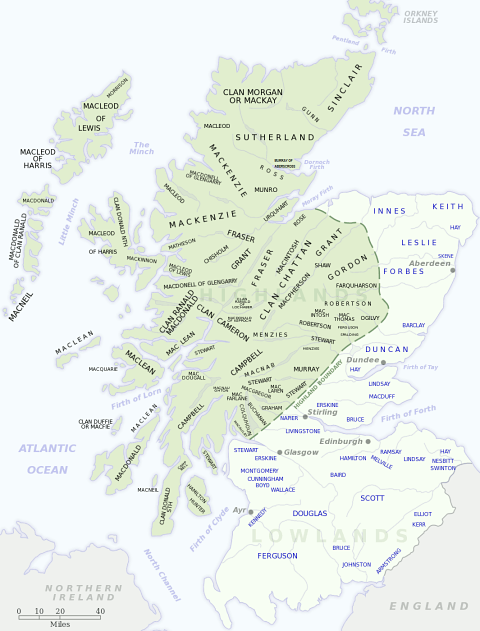
Distribution of Scottish clans and families
View larger map at Wikimedia Commons
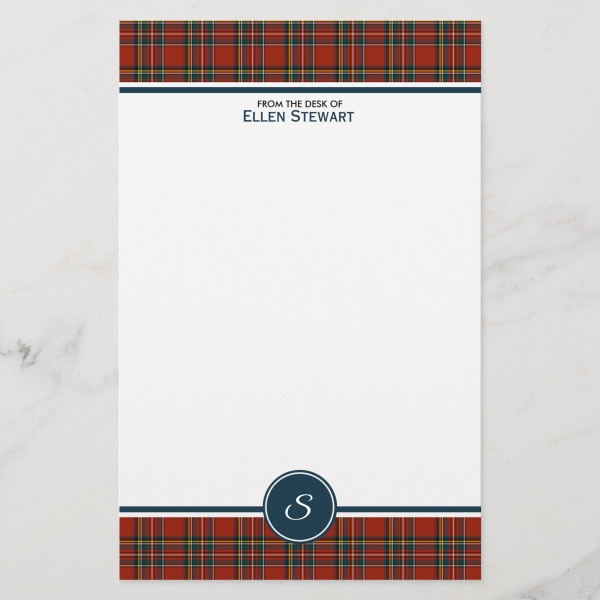
Browse the Royal Stewart Tartan Collection with home decor, personal accessories, crafting, paper products, and more.
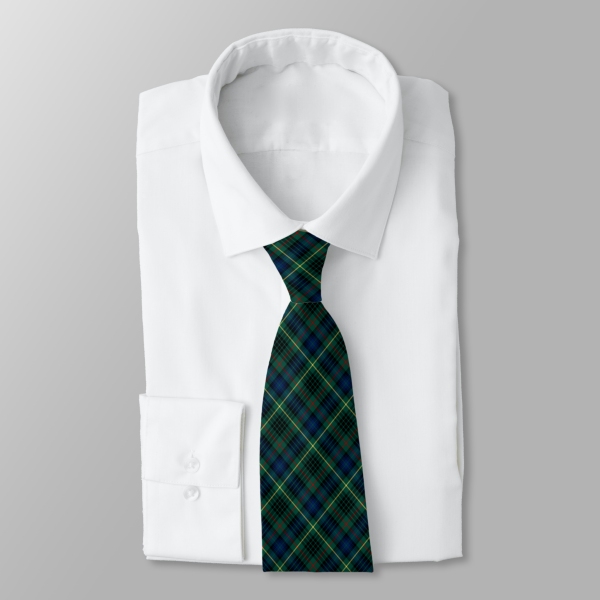
Browse the Clan Stewart Hunting Tartan Collection with home decor, personal accessories, crafting, paper products, and more.
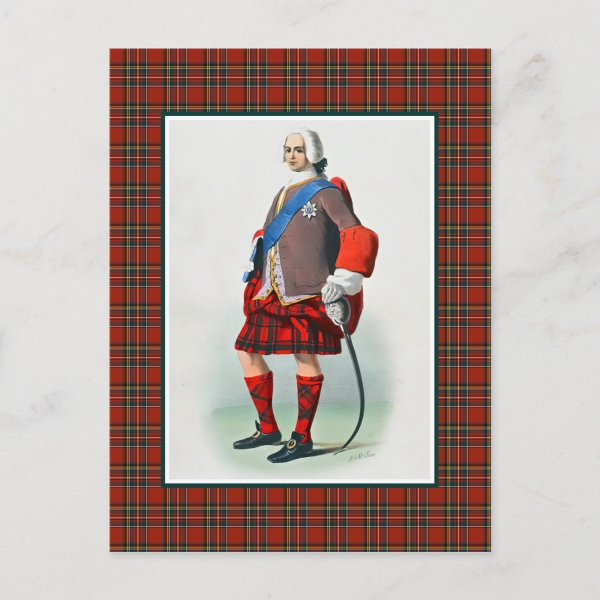
Clan Stewart Postcard: Digitally cleaned and enhanced vintage illustration with tartan frame.